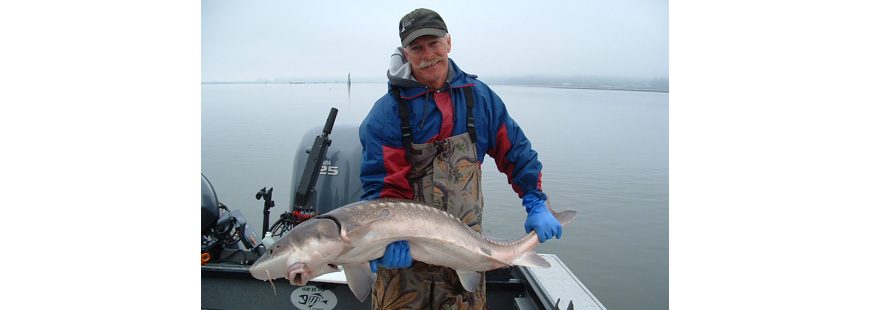How the Administration’s Actions Could Affect our Fisheries
Top Photo: Arizona Aubrey with a Tillamook Bay sturgeon
We’ve all been victims of regulation, and when President Trump rolled out his “1 new regulation in, 2 old ones out” executive order, I wasn’t sure that was such a bad idea. But then I got educated.
In the fishing world, we prosecute our fisheries under an umbrella of regulations. In an over-populated world with finite resources, how would we even have any natural resources left today if there were no regulations? That may be why I envy Lewis and Clark so much, limitless fish and wildlife, no regulation. In 1803, however, there was no need for regulation.
That in and of itself is worth pondering. In a little over two lifetimes, granted, long lifetimes, we went from no regulation to an intensive body of regulation, especially to protect our natural resources. With more people and more pressure on those natural resources comes regulation. Most of us have come to accept it, and many of us have learned to still thrive amongst the myriad of regulation that affects our way of life.
So, how would that work for the Magnuson-Stevens Act? Say America got greedy and decided to extend our EEZ (exclusive economic zone) out to 300 miles, instead of its current 200-mile zone. What would we do to satisfy the executive order (EO), drop forage fish protections? Reverse course on the overfishing component, rebuilding component or drop the protections of the essential fish habitat? Are you kidding me? Let me go out on a limb here, but maybe that EO wasn’t really thought out all that well.
I’m not sure I can think of a single instance of where reducing two old regulations to enact one new necessary one is a good idea. I have to believe there may be one out there, I just can’t think of it. Fishery regulations are reviewed on a fairly regular basis, and I’d like to think that managers and stakeholders would agree, at least here in the Pacific Northwest, that rollbacks of fishing regulations aren’t really a good idea. There is the rare case where regulations are enacted on emotion or politics versus sound science, however.
Even though most of us would agree we’re racked with regulation, what is the best way to alleviate ourselves of that regulation in fisheries management?
- First, you have to stop the bleeding – Cease the overfishing, the very problem that put you in a bind in the first place. Of course that means regulation. When a branch of government doesn’t have enough information to manage a population at a sustainable level, you have to give it your best shot based on the amount of science you do have available. Have you ever seen how much a stock assessment costs? A stock assessment that simply examines trends in populations can often cost between $30k and $50k. More complex ones that obviously yield more accurate numbers (if there is such a thing when counting fish in the Pacific Ocean) cost between $250k to $300k. I’m glad I don’t have to foot that bill.
- Second, you have to manage the fishery – That means more regulations, of course. Setting up exclusionary zones, monitoring catch and bycatch, and sampling take and trends are all labor intensive. You have to publish the new regulations and enforce them. That’s not cheap.
- Third, you have to actually rebuild the depressed stock of fish. For most stocks, with the exception of salmon, nature will do that for you, if said (and effective) regulations are in place. Just when I started liking the idea of consuming lingcod about 20 years ago, lingcod were deemed overfished so there went my fish and chips. Lingcod are the true West Coast success story of the country’s strongest federal fisheries law, Magnuson-Stevens. Although I’m having a hard time researching the history of lingcod limits in Oregon, just a few decades ago, there likely wasn’t a limit. Then it was 25 bottomfish in aggregate, now it’s seven. There was a period of time when anglers could take only one lingcod, but just a few short years later, we had some good brood years and now the limit is back to two lings, along with your seven rockfish.
You think that’s confusing, check out this year’s regulations. I haven’t been out for bottomfish just yet, but given the way the steelhead and salmon runs are likely to perform this year, I think I had better warm up my vacuum packer.
So to sum up, the 2-for-1 may be a good deal at a fast food restaurant or certainly a tackle store, but when it comes to fisheries management, maybe we should leave it up to the biologists. Let’s get out there and round up some fish tacos!



Always a good job right here. Keep rolling on thhrugo.